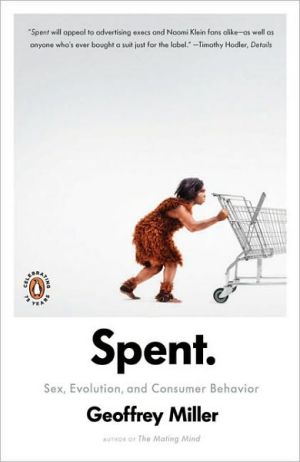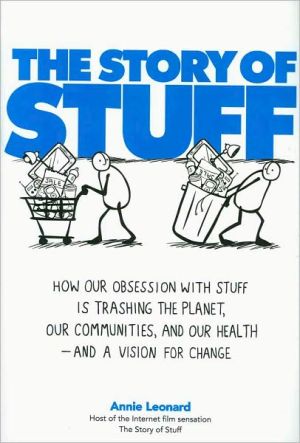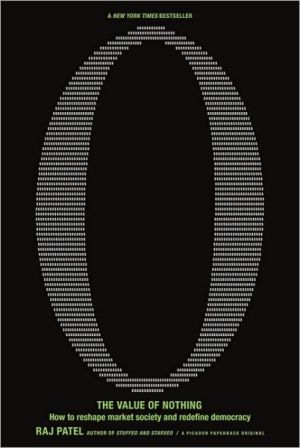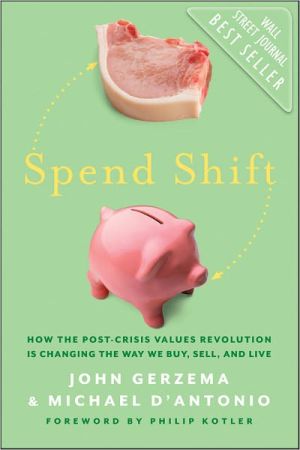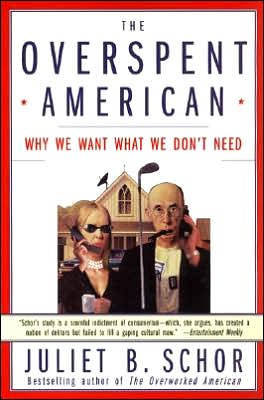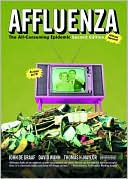Spent: Sex, Evolution, and Consumer Behavior
A leading evolutionary psychologist probes the unconscious instincts behind American consumer culture\ Illuminating the hidden reasons for why we buy what we do, Spent applies evolutionary psychology to the sensual wonderland of marketing and perceived status that is American consumer culture. Geoffrey Miller starts with the theory that we purchase things to advertise ourselves to others, and then examines other factors that dictate what we spend money on. With humor and insight, Miller...
Search in google:
A leading evolutionary psychologist probes the hidden instincts behind our working, shopping, and spendingEvolutionary psychology-the compelling science of human nature-has clarified the prehistoric origins of human behavior and influenced many fields ranging from economics to personal relationships. In Spent Geoffrey Miller applies this revolutionary science's principles to a new domain: the sensual wonderland of marketing and status seeking that we call American consumer culture. Starting with the basic notion that the goods and services we buy unconsciously advertise our biological potential as mates and friends, Miller examines the hidden factors that dictate our choices in everything from lipstick to cars, from the magazines we read to the music we listen to. With humor and insight, Miller analyzes an array of product choices and deciphers what our decisions say about ourselves, giving us access to a new way of understanding-and improving-our behaviors. Like Freakonomics or The Tipping Point, Spent is a bold and revelatory book that illuminates the unseen logic behind the chaos of consumerism and suggests new ways we can become happier consumers and more responsible citizens. Publishers Weekly Evolutionary psychologist Miller (The Mating Mind) examines conspicuous consumption in order to further his (not entirely complementary) goals-to rectify marketing's poor understanding of human spending behavior and critique consumerist culture. According to the author, our purchases are powerful indicators of our personality and are used to lure in suitable mates and friends. The book defends the current psychological view of personality as varying along six axes: intelligence, openness to new experiences, conscientiousness, agreeableness, emotional stability and extroversion. While there is significant support for the author's contention that variation in these basic categories reflect genetic inheritance, preferences for each of them vary from society to society, from historical moment to moment and even within individual lives (e.g., conscientiousness tends to increase over the course of our lives as mating strategies shift from attracting short-term partners to maintaining long-term relationships). Miller is an engaging writer, even if his attempts at humor fall flat. What remains troubling is his failure to account for how a full range of traits can coexist in the same cultural environment and continue to be perpetuated across generations. (May)Copyright © Reed Business Information, a division of Reed Elsevier Inc. All rights reserved.
1\ Darwin Goes to the Mall\ Consumerist capitalism: it is what it is, and we shouldn’t pretend otherwise.\ But what is it, really? Consumerism is hard to describe when it’s the ocean and we’re the plankton.\ Faced with the unfathomable, we could start by asking some fresh questions. Here’s one: Why would the world’s most intelligent primate buy a Hummer H1 Alpha sport- utility vehicle for $139,771? It is not a practical mode of transport. It seats only four, needs fifty- one feet in which to turn around, burns a gallon of gas every ten miles, dawdles from 0 to 60 mph in 13.5 seconds, and has poor reliability, according to Consumer Reports. Yet, some people have felt the need to buy it— as the Hummer ads say, “Need is a very subjective word.”\ Although common sense says we buy things because we think we’ll enjoy owning and using them, research shows that the pleasures of acquisition are usually short- lived at best. So why do we keep ourselves on the consumerist treadmill— working, buying, aspiring? Biology offers an answer. Humans evolved in small social groups in which image and status were all- important, not only for survival, but for attracting mates, impressing friends, and rearing children. Today we ornament ourselves with goods and services more to make an impression on other people’s minds than to enjoy owning a chunk of matter—a fact that renders “materialism” a profoundly misleading term for much of consumption. Many products are signals first and material objects second. Our vast social- primate brains evolved to pursue one central social goal: to look good in the eyes of others. Buying impressive products in a money- based economy is just the most recent way to fulfill that goal.\ Many bright thinkers have tried to understand modern consumerism by framing it in a historical context, asking, for example: How did we go from showing off our status with purple- bordered togas in ancient Rome to showing it off with Franck Muller watches in modern Manhattan? How did we go from the 1908 black Model- T Ford to the 2006 “Flame Red Pearl” Hummer? How did we go from eating canned tuna (about $4 per pound) to eating magical plankton (“marine phytoplankton, the ultimate nutrogenomic, supercharged with high- vibration crystal scalar energy healing frequencies”— $168 for fifty grams, or $1,525 per pound, from Ascendedhealth.com) as a luxury food?\ This book takes a different approach from that of historical analysis. It frames consumerism in an evolutionary context, and thus addresses changes across much longer spans of time. How did we go from being small- brained semisocial primates 4 million years ago to being the big- brained hypersocial humans we are today? At the same time it addresses differences across species. Why do we pay so much for plankton, the most common form of biomass on the planet? Blue whales eat four tons of it per day, which would cost $12.2 million per day (plus shipping) from Ascendedhealth.com, if they wanted the “nutrogenomic supercharging.”\ To understand consumerist capitalism, it might help to begin by considering our lives today as our prehistoric ancestors might view them. What would they think of us? Compared with their easygoing clannish ways, our frenetic status seeking and product hunting would look bewildering indeed. Our society would seem noisy, perplexing, and maybe psychotic. To see just how psychotic, let’s perform a thought experiment— something exotic, with time travel and lasers.\ From Cro-Magnons to Consumers\ This is your mission, should you choose to accept it: Go back thirty thousand years in a time machine. Meet some clever Cro-Magnons in prehistoric France. (We’ll assume that you’ll be able to speak their language, somehow.) Explain our modern system of consumerist capitalism to them. Find out what they think of it. Would the prospect of ever- greater prosperity, leisure, and knowledge motivate them to invent agriculture, animal husbandry, walled towns, money, social classes, and conspicuous consumption? Or would they prefer to stagnate at their Aurignacian level of culture, knapping flint and painting caves? Suppose you agree to this mission, and go back in your time machine. You find some Cro-Mags one evening, and get their attention by passing out a dozen laser pointers for them to play around with. After an hour they settle down, and you give your pitch, explaining that our culture offers a vast cornucopia of goods and services for showing off one’s personal qualities in ten thousand new ways to millions of strangers. One acquires these displays of personal merit by “buying” them with “money” earned through “skilled labor.” You promise that if they persist with their flint- knapping obsession, then in just a few millennia their descendants will be able to enjoy sophisticated cultural innovations, such as colonic irrigation and YouTube.\ Your talk goes well, and it’s time to gauge their reaction. You take some questions from the audience. One of the dominant adult males, Gérard, has been hooting with enthusiasm, and seems to get the idea. But Gérard has some concerns— most sound outrageously sexist to your modern ears, but since they are expressed with genuine curiosity, in the spirit of scientific objectivity you feel obliged to answer them honestly. Gérard inquires:\ So, Man-from-Future, with this money stuff, I could buy twenty bright young women willing to bear my children?\ You: No, Gérard. Since the abolition of slavery, we can’t offer genuine reproductive success in the form of fertile mates for sale. There are prostitutes, but they tend to use contraception.\ Gérard: Well, I shall have to seduce the women so they want to breed with me. Can I buy more intelligence and charisma, better abilities to tell stories and jokes, more height and muscularity?\ You: No, but you can buy self- help books that have some placebo effect, and some steroids that increase both muscle mass and irritability by 30 percent.\ Gérard: OK, I will be patient and wait for my sexual rivals to die. Can I buy another hundred years of life?\ You: No, but with amazing modern health care, your expected life span can increase from seventy years to seventy- eight years.\ Gérard: These no- answers anger me, and I feel aggressive. Can I buy advanced weaponry to kill my rivals, especially that bastard Serge, and the men of other kin groups and clans, so I can steal their women?\ You: Yes. One effective choice would be the Auto Assault- 12 shotgun, which can fire five high- explosive fragmenting antipersonnel rounds per second. Oh— but I guess then the rivals and other kin groups and clans would probably buy them, too.\ Gérard: So, we’d end up at just another level of clan- versus- clan détente. And there would be more lethal fights among hotheaded male teens within our clan. Then I shall be content with my current mate, Giselle— can I buy her undying devotion, and multiple orgasms so she never cheats on me?\ You: Well, actually, lovers still cheat under capitalism; paternity uncertainty persists.\ Gérard: What about Giselle’s mother and sister— can I buy them kinder personalities, so they are less critical of my foibles?\ You: Sadly, no.\ Then Giselle, Gérard’s savvy mate, interrupts with a few questions of her own, which you answer with ever- increasing dismay:\ Giselle: Man- from- Future, can I buy a handsome, high- status, charming lover who will never ignore me, beat me, or leave me?\ You: No, Giselle, but we can offer romance novels that describe fictional adventures with such lovers.\ Giselle: Can I buy more sisters, who will care for my younger children as they would their own, when I am away gathering gooseberries?\ You: No, child- care employees tend to be underpaid, overwhelmed, miseducated girls who care more about text messaging their friends than looking after the children of strangers.\ Giselle: How about our teenage children— Justine and Phillipe? Can I buy their respect and obedience, and the taste to choose good mates?\ You: No, marketers will brainwash them to ignore your social wisdom and to have sex with anyone wearing Hollister- branded clothing or drinking Mountain Dew AMP Energy Overdrive.\ Giselle: Zut, alors! Mange de la merde et meurs! This money stuff sounds useless. Can I at least buy a mammoth carcass that never rots?\ Finally, you see an opening, and you start explaining about Sub- Zero freezers— but then you remember that there is not yet an Electricité de France with fifty- nine nuclear reactors to supply freezer power, and you falter.\ Giselle and Gérard are by now giving you looks of withering contempt. The rest of your audience is restless and skeptical; some even try to set you on fire with their laser pointers. You try to rekindle their interest by explaining all the camping conveniences that consumerism offers for the upwardly mobile Cro-Mag: sunglasses, steel knives, backpacks, and trail- running shoes that last several months, with cool swooshes on the sides.\ The audience perks up a bit, and Giselle’s mother, Juliette, asks, “So, what’s the catch? What would we have to do to get these knives and shoes?” You explain, “All you have to do is sit in classrooms every day for sixteen years to learn counterintuitive skills, and then work and commute fifty hours a week for forty years in tedious jobs for amoral corporations, far away from relatives and friends, without any decent child care, sense of community, political empowerment, or contact with nature. Oh, and you’ll have to take special medicines to avoid suicidal despair, and to avoid having more than two children. It’s not so bad, really. The shoe swooshes are pretty cool.” Juliette, the respected Cro-Magnon matriarch, looks you straight in the eye and asks, with infinite pity, “Are you out of your mind?”\ Contrasts and Choices\ This thought experiment has, I hope, shaken your faith that humanity has ridden a one- way escalator of ever- increasing progress and evergreater happiness since the Aurignacian. True, modern life can be a wondrous glee-glutted Funky Town for the wealthiest .01 percent of people on the planet. However, a fairer assessment would contrast the lifeways of an average prehistoric human and the lifestyle of an average modern human.\ Consider the average Cro-Magnon of thirty thousand years ago. She is a healthy thirty- year- old mother of three, living in a close- knit clan of family and friends. She works only twenty hours a week gathering organic fruits and vegetables and flirting with guys who will give her free- range meat. She spends most of her day gossiping with friends, breast- feeding her newest baby, and watching her kids play with their cousins. Most evenings she enjoys storytelling, grooming, dancing, drumming, and singing with people she knows, likes, and trusts. Although she is only averagely intelligent, attractive, and interesting, most of her clan mates are too, so they get along just fine. Her boyfriend is also only average, but they often have great sex, since males have evolved wonderful new forms of foreplay: conversation, humor, creativity, and kindness. (About once a month, she hooks up secretly with her enigmatic lover, Serge, who has eleven confirmed Neanderthal kills, but whose touch is like warm rain on Alpine flowers.) Every morning she wakes gently to the sun rising over the six thousand acres of verdant French Riviera coast that her clan holds. It rejuvenates her. Since the mortality rate is very low after infancy, she can look forward to another forty years of life, during which she will grow ever more valued as a woman of wisdom and status.\ Now consider the average American worker in the twenty- first century. She is a single thirty- year- old cashier, who drives a Ford Focus and lives in Rochester. She is averagely intelligent (IQ 100), having gotten Cs in a few classes before dropping out of the local community college. She now has this job in retail, working forty hours a week at the Piercing Pagoda in EastView Mall, fifty miles from her parents and siblings. She is just averagely attractive and interesting, so she has a few friends, but no steady boyfriend. She has to take Ortho Tri- Cyclen pills to avoid getting pregnant from her tipsy sexual encounters with strangers who rarely return her phone calls. Her emotional stability is only average, and because Rochester is dark all winter, she takes Prozac to avoid suicidal despair. Every evening she watches TV alone. Every night she fantasizes about being loved by Johnny Depp and being friends with Gwen Stefani. Every morning she awakens to the alarm clock next to the fake Chinese rubber plant in her six- hundredsquare- foot apartment. It wears her out. Thanks to modern medicine, she can look forward to another forty- five years of life, during which she will become ever less valued as an obsolete health- care burden. At least she has an iPod.\ By envisioning our current lives through our ancestors’ eyes, we can see more clearly what we have given up, and what we have gained, from developing this thing called “civilization,” which nowadays means consumerist capitalism. We can also better distinguish what is truly natural about our lives from what is historically accidental, culturally arbitrary, or politically oppressive.\ Consumerist capitalism, as humans practice it in any particular culture, is not a natural or inevitable outcome of human evolution, given a certain level of technological sophistication. An evolutionarypsychology analysis of consumerism is accordingly not a way of giving science’s seal of approval to consumerism, nor is it a way of morally justifying consumerism as the highest possible stage of biocultural progress. Many thinkers have tried to “naturalize” consumerism in that way, including most social Darwinists, Austrian School economists (Ludwig von Mises, Friedrich Hayek, Murray Rothbard), Chicago School economists (George Stigler, Milton Friedman, Gary Becker), Darwinian libertarians, globalization advocates, management gurus, and marketers. Their model (which I call the Wrong Conservative Model, because I think it’s wrong, and because it’s usually advocated by political conservatives) is:\ human nature + free markets = consumerist capitalism\ Against such attempts to “naturalize” consumerism, others have rejected any concept of “human nature” and any connection between biology and economics. These bio- skeptics include most Marxists, anarchists, hippies, utopians, New Age sentimentalists, gender feminists, cultural anthropologists, sociologists, postmodernists, and antiglobalization activists. For now, suffice it to say that such radicals propose the Wrong Radical Model, which is basically:\ the blank slate + oppressive institutions + invidious ideologies = consumerist capitalism\ Here, the “blank slate” means a human baby’s big brain, allegedly born without any evolved instincts, preferences, or adaptations, yet capable of learning anything. (Steven Pinker trenchantly critiqued the possibility of such a brain in his book The Blank Slate.) The “oppressive institutions” are usually taken to be governments, corporations, schools, and media, as they inevitably represent the interests of some ruling class. The “invidious ideologies” are usually assumed to include religion, patriarchy, conformism, elitism, ethnocentrism, and mainstream economics. The Wrong Radical Model also usually assumes that Darwinism was invented as a justification for Victorian- era capitalism, including classism, colonialism, sexism, and racism— and if it’s part of the problem, it can’t be part of the solution.\ As an alternative to the Wrong Conservative Model (consumerism as natural) and the Wrong Radical Model (consumerism as cultural oppression), this book proposes something a bit more complicated but, I hope, more accurate. I call it the Sensible Model, because I think it’s pretty reasonable, given what science has discovered so far about people and societies. It goes like this:\ human instincts for trying unconsciously to display certain desirable personal traits\ + current social norms for displaying those mental traits through certain kinds of credentials, jobs, goods, and services\ + current technological abilities and constraints\ + certain social institutions and ideologies\ + historical accident and cultural inertia\ = early twenty- first- century consumerist capitalism\ This more complex (but still vastly oversimplified) model does not just “denaturalize” consumerism. It also identifies specific things we could change about society by changing our social norms, institutions, ideologies, cultures, and technologies. The last third of this book suggests some possible ways to reengineer consumerist capitalism based on the Sensible Model.\ These suggested changes will not aim to restore Cro-Magnon living conditions, which would be neither possible nor desirable for modern humans. There are 6.7 billion people on earth, and we can’t all go back to living as hunter- gatherers. The notion of returning to an idealized paradise of simple, gentle, small- group living has been advocated by diverse visionaries throughout history: Buddha, Laozi, Epicurus, Thoreau, Engels, Gandhi, Margaret Mead, and the Unabomber. Often these visionaries attract followers, who form religions, political movements, or whole cultures: Taoists, Shakers, Luddites, Marxists, anarchists, hippies, and Emo kids. Even mainstream “bourgeois bohemians” support sustainability, voluntary simplicity, intentional living, organic farming, and corporate social responsibility, and try to smuggle some aspects of eco- communo- primitivism into their gated communities, insofar as local zoning permits them.\ Yet each of these individuals and groups has exaggerated both the pros of primitive life and the cons of modern life. Each intuits correctly that a Cro-Magnon lifestyle was a more natural environment for the human body, mind, family, and clan. Yet at the same time, each forgets that, stripped of romantic idealization, Cro-Magnon life was also ignorant, insular, violent, and unimaginably boring. I would not want to live without civilization’s key inventions— trade, currency, literacy, medicine, books, bicycles, films, duct tape, shipping containers, and computers. Unlike many malcontents, I consider the three best inventions of all time to be money, markets, and media. Each has radically increased the social and material benefits of peaceful human cooperation. But together they don’t necessarily add up to consumerist capitalism in its current forms.\ Fortunately, we are not forced to make an either- or choice between (1) eco- communo- primitivism as it might function in some elusive utopia, and (2) consumerist capitalism as it happens to have metastasized so far in some human societies. The Sensible Model suggests that there are many alternatives, and I think some of them combine the best natural features of prehistoric life and the best inventions of modern life.\ Mamas, Don’t Let Your Babies Grow Up to Be Marketing Consultants\ Cro-Magnons aside, modern society also looks bewildering to children. They are born with paleo brains, built from paleo genes, expecting a paleo world: a close- knit social environment of kin- based hunter- gatherer clans. Children are wired to learn and play the normal game of life for which they evolved: be cute, grow up, find food, make friends, care for kin, avoid dangers, fight some enemies, find some mates, raise some kids, grow old and wise, die. Instead, they face a bizarre new world of frustrating duties and counterintuitive ideas: sit still, learn math, find a job, move away from friends, ignore kin, drive cars, leave kids in day care, and grow burdensome in old age.\ Children face this new world with minimal guidance. Their parents go away all day to make money, to buy things, to look good and special, and to attract extra attention from other men and women, despite having mated and reproduced already. Their parents can’t explain why they pretend that they’re still in the mating market if they don’t actually want a divorce and custody battle. Their high school teachers can’t make sense of the consumerist world for them either, and their college professors can only suggest reading perplexing rants from postmodern French sociologists, such as Jean Baudrillard. So, almost everyone grows up confused, passes through life confused, and dies confused. Only a few children do ever gain an intuitive grasp of consumerism’s principles, and these typically grow up to be marketing consultants. They learn that people in general are motivated, at least unconsciously, to flaunt and fake their personal merits and virtues to one another. They realize that modern consumers in particular strive to be self- marketing minds, feeding one another hyperbole about how healthy, clever, and popular they are, through the goods and services they consume. Marketing consultants build careers around the postmodern insight: at its heart consumerist capitalism is not “materialistic,” but “semiotic.” It concerns mainly the psychological world of signs, symbols, images, and brands, not the physical world of tangible commodities. Marketers understand that they are selling the sizzle, not the steak, because a premium brand of sizzle yields a high margin of profit, whereas a steak is just a low- margin commodity that any butcher could sell.\ However, even the cleverest marketers still don’t fully understand which merits and virtues consumers are really trying to display through their consumption decisions. They don’t really understand the content of the signals that people send to one another. Typically, marketers get some formal education in outdated consumer psychology research, then they get real jobs at real companies and realize that their formal training is mostly useless in selling real products. In response, they strive to develop an intuitive understanding of consumer behavior and marketing strategies through years of trial- and- error learning, plus the occasional book by Seth Godin or Malcolm Gladwell. They lack the huge practical benefits of having a coherent evidence- based theory about consumer behavior, and this limits their success rate.\ In particular, most marketers still use simplistic models of human nature that remain uninformed by the past twenty years of research on human nature— research by evolutionary anthropologists, evolutionary biologists, and evolutionary psychologists. Marketers still believe that premium products are bought to display wealth, status, and taste, and they miss the deeper mental traits that people are actually wired to display— traits such as kindness, intelligence, and creativity. They don’t put consumption in its evolutionary context, or trace its prehistoric roots, or understand its adaptive functions. As a result, they don’t have access to a good map of the human mind, or of this brave new semiotic world in which it dwells. What marketers need is Darwin.\ Yet Darwin, in turn, needs to take a break from fieldwork and visit the mall. The Darwinian science of human nature needs to shift some attention from Pleistocene evolution to twenty- first- century consumer behavior. We need to understand in much deeper ways how people flaunt and fake their biological fitness— their prospects for survival and reproduction— to one another. We need to understand the specific facets of fitness— the most important physical and psychological traits— that people strive to display through their “fitness indicators,” including most of the products they buy.\ Fitness Indicators\ Fitness indicators are signals of one individual’s traits and qualities that are perceivable by other individuals. Almost every animal species has its own fitness indicators to attract mates, intimidate rivals, deter predators, and solicit help from parents and kin. Male guppies grow flaglike tails, male lions sport luxuriant manes, male nightingales learn songs, male bowerbirds build bowers, humans of both sexes acquire luxury goods. In each case, the fitness indicators are advertising fundamental biological traits such as good genes, good health, and good social intelligence.\ The animals that possess them are not consciously aware that these traits evolved to advertise their fitness. They just have the genes and instincts for displaying them, and evolution itself keeps track of the survival, social, and sexual benefits of doing so. We humans may not have much more conscious insight into the biological functions of our fitness indicators than guppies have into the functions of their flaglike tails. Indeed, we often buy products that increase our apparent fitness (health, beauty, fertility, intelligence) at the cost of real biological fitness (reproduction)— for example, Ortho Tri- Cyclen birth control pills make women’s skin look more attractive by reducing acne, but it lowers reproductive success by eliminating ovulation. Our brains did not evolve to pursue reproductive success consciously, but to pursue the cues, experiences, people, and things that typically led to reproductive success under ancestral conditions.\ Successful reproduction requires males and females to follow different sexual strategies, and to display their fitness indicators to different audiences. Across virtually all animal species, males display mostly to attract female mates, and less often to intimidate male sexual rivals. It is easy to see the functional connection between peacock tails and Porsches, and many recent studies have confirmed that men increase the conspicuousness of their consumption when they are most interested in mating. The situation is more complex for females.\ Female animals of most species gain little benefit from displaying fitness indicators to either sex, except in species where females compete for resources and mates, or where males are selective about their mates. Among the highly social great apes, for example, female status hierarchies are important in predicting female access to food, so female apes often compete for status by displaying fitness indicators to one another— such as their size, health, assertiveness, and popularity during mutual grooming. Such female- versus- female status competition probably likewise accounts for most conspicuous consumption by human females, especially for products such as Prada handbags and Manolo Blahnik shoes, which straight males rarely notice. Humans are even more distinctive in that males are fairly choosy about the females with whom they form long- term relationships, which means that females also compete to attract the higher- quality males. Sadly, the evidence so far suggests that men pay very little attention to such conspicuous consumption by women.\ Unlike other animals, humans have evolved unique abilities to invent, make, display, and imitate new kinds of fitness indicators. These new indicators evolve at the cultural rather than genetic level, and they include many of the credentials, jobs, goods, and services that are typical in modern economies. Juvenile humans have an insatiable thirst to learn about culture- specific indicators, gossiping endlessly about what is “cool,” “hot,” “phat,” “rad,” or “wicked.” In other words, they are trying to discern “Which products would display my traits, tastes, and skills most effectively, given the current display tactics favored by my peer group, especially its more socially and sexually attractive members?” If local status depends on memorizing longer passages of the Torah or Qur’an than others can, young people will learn to do that; if it depends on getting higher “interestingness” scores on one’s Flickr- posted photos, or a higher friend- count on Facebook, or higher “hotness” ratings on Hotornot.com, they will opt for those instead. Just as toddlers have special brain systems that evolved to learn whatever language is spoken locally, teens seem to have evolved similar systems to learn whatever culture- specific fitness indicators are favored in their local eco- niche, social niche, or market niche. We are not just intuitive linguists; we are also intuitive status- ticians. In each case, evolution has crafted our innate ability to acquire culturally modulated communication skills.\ In humans, fitness indicators are unlikely to have evolved to advertise monetary wealth, career- based status, or avant- garde taste, because these phenomena arose quite recently on the evolutionary timescale, within the past ten thousand years. Rather, the key traits that we strive to display are the stable traits that differ most between individuals and that most strongly predict our social abilities and preferences.\ These include physical traits, such as health, fertility, and beauty; personality traits, such as conscientiousness, agreeableness, and openness to novelty; and cognitive traits, such as general intelligence. These are the biological virtues that people try to broadcast, with the unconscious function of attracting respect, love, and support from friends, mates, and allies. Displaying such traits is the key “latent motive” that marketers strive to comprehend. While consumers do strive semi consciously to show off their wealth, status, and taste, I’ll argue that they do so largely in order to reveal these more fundamental biological virtues. Certainly, money can function as a form of “liquid fitness,” but largely as a means of acquiring more conspicuous fitness indicators. And while consumers do rely more on emotions than on reason in deciding what to buy, human emotions cannot be described clearly without understanding their evolutionary origins and functions. Until marketers and consumers understand these principles deeply, in vivid Technicolor detail, and with a bittersweet ambivalence about the human condition, we will have little hope of improving and enlightening society.\ Description and Prescription\ This book has two main aims. The first is to describe our human culture as it is, within a biological context. The second is to suggest some ways that we could change our human culture so it more happily combines the best features of prehistoric social life and modern technology.\ Inevitably, my descriptions and prescriptions will get mixed together in the course of my discussion. They will interlace at every scale, from recurring book themes down to specific product examples, as I shift between considering facts and values. Such promiscuous hybridizations of “is” and “ought” often provoke outrage among the superhumanly rational philosophers of science and morality, who prefer that behavioral scientists restrict themselves to objective reportage and leave the preaching to them, or to their religious counterparts.\ Too bad. There is a distinguished tradition of gaining new prescriptive insights into one’s society through new ways of describing its follies and injustices— a tradition that includes such names as John Locke, Mary Wollstonecraft, Daniel Defoe, William Wilberforce, Henry David Thoreau, Karl Marx, Max Weber, Margaret Sanger, Thorstein Veblen, John Kenneth Galbraith, Alfred Kinsey, Germaine Greer, and Peter Singer. I hope to scramble along like a dormouse in their footsteps\ .\ If my descriptive analysis proves accurate, it should be useful to different readerships with conflicting agendas. It should give marketers new ways to exploit consumer preferences and make more money. It should also give consumers new ways to resist marketer influence and save money. It may give conservatives new ways to justify some aspects of the status quo, given the ubiquity of conspicuous display throughout nature. It may also give progressives new ways to undermine that status quo, given the colossal inefficiency of conspicuous consumption as a form of trait display. While I can’t control who reads this book, what insights they derive from it, or how they apply those insights in their lives and livelihoods, I can hope that a more accurate view of human nature and consumerist culture leads to more intelligent debate about all its relevant issues.\ Consumerist Ambivalence\ Like most reasonable people, I feel deep ambivalence about marketing and consumerism. Their power is awe- inspiring. Like gods, they inspire both worshipful submission and mortal terror. Consumerist capitalism produces almost everything that is distinctively exciting about modern life and almost everything that is appalling about it. Most people like clothing, shelter, safety, education, medicine, and travel, and would miss them if they lived in an eco- communo- primitivist utopia. Most people dislike exploitation, workaholism, runaway debt, pollution, the military- industrial complex, cartels, corruption, alienation, and mass depression, and would not miss them. Then there are personal tastes. The things I find most exciting about consumerist capitalism include:\ almond croissants, Tori Amos concerts, skiing at Telluride, houses designed by Bart Prince, the BMW 550i, Provigil, iPods full of Outkast and Radiohead songs, and the Microsoft Ergonomic keyboard on which I’m typing. The things I find most appalling: Las Vegas, the Mall of America, fast food, cable television, Hummers, and overpriced phytoplankton. Then there are the things that seem both exciting and appalling: frappuccinos, business schools, In Style magazine, Glock handguns, Jerry Bruckheimer movies, Dubai airport duty-free shops, Diet Code Red Mountain Dew, the contemporary art market, and Bangkok. You can draw up your own lists, and contemplate your own sources of consumerist ambivalence.\ Unfortunately, most writing about consumerism shows either pure love or pure hate, with no balance or nuance. On the one hand, we have pro- consumerism advocacy: the World Trade Organization, World Bank, and World Economic Forum; the Economist and the Wall Street Journal; marketers, corporate lobbyists, and libertarians. On the other hand, we have anticonsumerism activism: Greenpeace, Earth First, Naomi Klein’s No Logo, Adbusters magazine, the New Urbanism, voluntary simplicity, the Slow Food movement, the Fair Trade movement, Buy Nothing Day, and True Cost Economics.\ The extremism in either case is . . . extreme. Both sides have been shouting past each other for decades. My goal here is not to conduct a cost- benefit analysis of consumerism, or to reach some simplistic good versus bad judgment. Rather, my hope is that by grounding our understanding of consumerism in the biological realities of human nature and individual differences, pro- consumerism and anti- consumerism advocates can find a higher, closer, common ground. It’s not enough to recognize that both sides have some good points and good intentions. We need to step back from the contemporary debate and reassess it from the broadest, deepest possible perspective— not only from a cross- cultural, historical perspective, but also from a cross- species, evolutionary perspective.
1 Darwin Goes to the Mall 12 The Genius of Marketing 193 Why Marketing Is Central to Culture 374 This Is Your Brain on Money 525 The Fundamental Consumerist Delusion 716 Flaunting Fitness 907 Conspicuous Waste, Precision, and Reputation 1128 Self-Branding Bodies, Self-Marketing Minds 1289 The Central Six 14410 Traits That Consumers Flaunt and Marketers Ignore 17111 General Intelligence 18712 Openness 20713 Conscientiousness 22514 Agreeableness 24015 The Centrifugal Soul 25516 The Will to Display 27717 Legalizing Freedom 308Exercises for the Reader 331Further Reading and Viewing 336Acknowledgments 362Index 363
\ Publishers WeeklyEvolutionary psychologist Miller (The Mating Mind) examines conspicuous consumption in order to further his (not entirely complementary) goals-to rectify marketing's poor understanding of human spending behavior and critique consumerist culture. According to the author, our purchases are powerful indicators of our personality and are used to lure in suitable mates and friends. The book defends the current psychological view of personality as varying along six axes: intelligence, openness to new experiences, conscientiousness, agreeableness, emotional stability and extroversion. While there is significant support for the author's contention that variation in these basic categories reflect genetic inheritance, preferences for each of them vary from society to society, from historical moment to moment and even within individual lives (e.g., conscientiousness tends to increase over the course of our lives as mating strategies shift from attracting short-term partners to maintaining long-term relationships). Miller is an engaging writer, even if his attempts at humor fall flat. What remains troubling is his failure to account for how a full range of traits can coexist in the same cultural environment and continue to be perpetuated across generations. (May)\ Copyright © Reed Business Information, a division of Reed Elsevier Inc. All rights reserved.\ \ \ \ \ Library JournalEvolutionary psychologist Miller (The Mating Mind) digs deep into the primal past of humankind to discover the roots of...modern marketing? Actually, his focus is more on the makings of modern consumer culture-of which marketing is, he argues, a dominant force. Since evolutionary psychology seeks to examine how natural selection acts on psychological and mental traits, Miller applies this knowledge to help us understand what actually motivates us to buy. He pokes fun at popular culture and at the things we buy and flaunt to inflate our self-esteem and try to make ourselves more attractive. Personality research can inform the study of consumer behavior, and Miller shows us how having a better understanding of our own personalities will help us avoid the pitfalls of runaway consumerism. After all, millions of years of evolution have honed humans' natural abilities to win friends and mates, so why resort to expensive and ridiculous substitutes for our true identities and personalities? For both lay readers and academics, reading this book should be considered time well "spent."\ —Carol J. Elsen\ \ \
